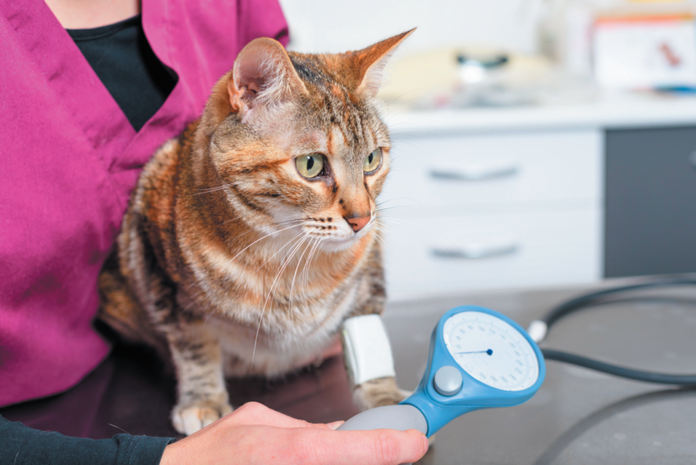Considering how much most cats hate going for veterinary checkups, it shouldn’t come as a surprise that checking feline blood pressure often goes by the wayside at the doctor’s office. But high blood pressure, known medically as hypertension, can be a sign of a number of serious conditions, notably kidney disease, heart disease, hyperthyroidism, and eye problems. (When blood pressure goes too high, the retina can detach and blindness can ensue.) The earlier in the disease process those conditions are identified by screening for elevated blood pressure, the more effective the treatment and the less damage done to your pet.
Conversely, if a vet finds a cat’s blood pressure to be abnormally high after one of these diseases has been diagnosed, keeping it in check can prevent the illness from advancing as quickly and causing more harm. Often, simply treating the condition lowers blood pressure significantly by itself, keeping it from causing further collateral damage.
Because hypertension and serious disease go hand in hand, it’s a good idea to ask your veterinarian to check your cat’s blood pressure from time to time, even if your instinct is to get your unhappy cat out of the exam room as soon as possible. This is especially important once your cat passes the age of 9 or so — high blood pressure is much more common in older felines. Sometimes a good trick is to check the blood pressure before starting the regular examination, certainly before the temperature is taken.
There are two numbers in a blood pressure reading: the systolic, or top number, which is the pressure of blood coursing against the walls of the blood vessels during a heart beat; and the diastolic, or lower number, which is the pressure of the blood making its way through the vessels between beats. Unlike in people, there is no established cutoff for high diastolic pressure. Veterinarians generally agree that a systolic pressure above 160 means the cat has hypertension. That much pressure on the walls of the blood vessels causes them wear and tear that then can adversely affect various body systems.
Treatment approach
Whereas in people, the arsenal of treatments for hypertension includes dietary modifications, such as limiting sodium (salt) intake, in cats it’s all about drug therapies. Among the preferred drugs is amlodipine. A calcium channel blocker, it works by slowing the movement of calcium into the heart and blood vessel walls. That, in turn, makes it easier for the heart to pump blood while it widens the blood vessels by “relaxing” them. The wider the vessels, the less pressure exerted on their walls as a given amount of blood rushes through them.
Another class of drugs your veterinarian might try, particularly if the amlodipine doesn’t work well enough, are ACE inhibitors such as benazepril. ACE inhibitors work by preventing an enzyme in the body from producing a substance called angiotensin II, which narrows the blood vessels. In some cats, a calcium channel blocker and an ACE inhibitor together make the best solution when neither will do enough to lower blood pressure on its own.
A new family of drugs, angiotensin receptor blockers, has also recently been shown to have promise in cats with hypertension. One of them, telmisartan, is a drug licensed to treat hypertension in cats with a systolic blood pressure under 200. Like the other angiotensin receptor blockers, it works not by inhibiting the production of angiotensin II but by blocking its effects.
Less commonly used are diuretics, which flush fluid from the body and thereby reduce blood volume, and beta blockers, which make the heart beat more slowly and with less force so that blood doesn’t get pumped through the arteries and veins too vigorously.
The trial and error of which drug or drugs to use is worth it. Diagnosing and treating hypertension early in the game not only can uncover associated diseases that need to be controlled, but in and of itself can help prevent unnecessary blindness, avoid end-stage heart failure, and slow the progression of kidney disease.





It makes a lot of sense to check the blood pressure on a cat! I have never seen this done on any of my cats anywhere! Crazy, since it seems so related to many health concerns in cats. As an NP in the human world I know there are studies showing that home blood pressures can actually be more accurate on humans, I am wondering if owners can do their own BPs on their cats? Maybe that would give a more accurate reading since they would probably be calmer at home. I would love to hear your thoughts!